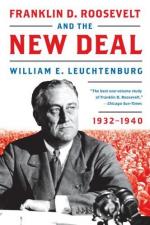
|
| Name: _________________________ | Period: ___________________ |
This test consists of 5 multiple choice questions, 5 short answer questions, and 10 short essay questions.
Multiple Choice Questions
1. After the election in November of 1932, during which month is Roosevelt inaugurated?
(a) December.
(b) March.
(c) February.
(d) January.
2. By the time Roosevelt is inaugurated, how many states have closed their banks?
(a) 23.
(b) 38.
(c) 49.
(d) 14.
3. As more and more American workers organize themselves into labor unions in 1933-35, Roosevelt is faced with having to decide what which provision of the National Industrial Recovery Act actually means?
(a) 9 (c).
(b) 7 (a).
(c) 2 (d).
(d) 4 (b).
4. Which of the following railroads does "The Politics of Hard Times" mention as a common ride for homeless Americans in search of work?
(a) New York Central.
(b) Burlington Northern.
(c) Rock Island.
(d) Union Pacific.
5. As "The Politics of Hard Times" opens, how many years does Leuchtenburg say Hoover has been President?
(a) 3.
(b) 1.
(c) 2.
(d) 4.
Short Answer Questions
1. On which of the following dates does the special session of Congress convene in "The Hundred Days' War"?
2. What is the name of the popular radio pastor in "Waiting for Lefty" who first supports Roosevelt but begins to waver soon after the election?
3. Upon receiving his appointment from Roosevelt, the new head of the Recovery Administration memorably remarks that it will be "red fire at first" and dead what afterward?
4. When Roosevelt asks Congress for legislation to regulate the Stock Exchange in February of 1934, which of the following men--President of the Stock Exchange--is outraged?
5. According to "Winter of Despair," which of the following words appears most frequently in the writings of New Deal theorists?
Short Essay Questions
1. Describe the relationship between Roosevelt and Reverend Coughlin and how it changes from 1932-1934.
2. In "Over the Top," what problem did the Liberty League have with Roosevelt's administration?
3. Explain the political game Hoover tried to get Roosevelt to play in November and December of 1932 in regard to the Anglo-French war debt.
4. In "The Politics of Hard Times," why was the Republican party sure to lose the 1932 election?
5. What was the purpose of the Works Progress Administration created in 1935, and under what primary rule did it function?
6. Explain the Old Age Revolving Pensions proposal put forth by Doctor Townsend, as discussed in "Waiting for Lefty."
7. Explain how Roosevelt was finally able to collect enough delegates to make him the Democratic nominee for President in 1932.
8. During the 1932 election, how badly did Herbert Hoover lose to Roosevelt?
9. Why did Secretary Wallace order the destruction of the cotton crop in 1933, and how were farmers compensated for their losses?
10. Describe the nation's reaction to Roosevelt's first Fireside Chat on March 12, 1933.
|
This section contains 1,449 words (approx. 5 pages at 300 words per page) |

|




